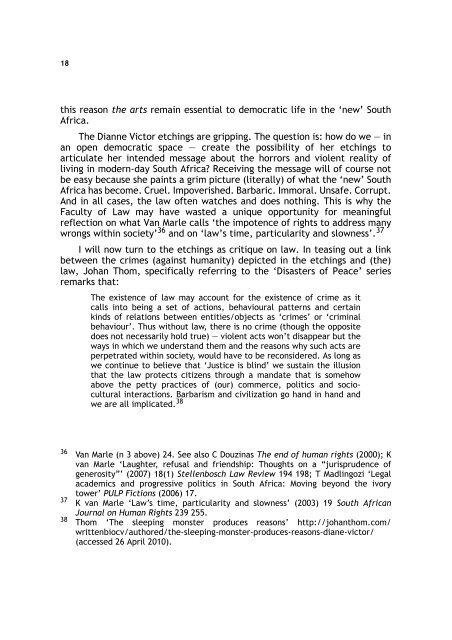Download this publication - PULP - University of Pretoria
Download this publication - PULP - University of Pretoria
Download this publication - PULP - University of Pretoria
Create successful ePaper yourself
Turn your PDF publications into a flip-book with our unique Google optimized e-Paper software.
18<br />
<strong>this</strong> reason the arts remain essential to democratic life in the ‘new’ South<br />
Africa.<br />
The Dianne Victor etchings are gripping. The question is: how do we — in<br />
an open democratic space — create the possibility <strong>of</strong> her etchings to<br />
articulate her intended message about the horrors and violent reality <strong>of</strong><br />
living in modern-day South Africa? Receiving the message will <strong>of</strong> course not<br />
be easy because she paints a grim picture (literally) <strong>of</strong> what the ‘new’ South<br />
Africa has become. Cruel. Impoverished. Barbaric. Immoral. Unsafe. Corrupt.<br />
And in all cases, the law <strong>of</strong>ten watches and does nothing. This is why the<br />
Faculty <strong>of</strong> Law may have wasted a unique opportunity for meaningful<br />
reflection on what Van Marle calls ‘the impotence <strong>of</strong> rights to address many<br />
wrongs within society’ 36 and on ‘law’s time, particularity and slowness’. 37<br />
I will now turn to the etchings as critique on law. In teasing out a link<br />
between the crimes (against humanity) depicted in the etchings and (the)<br />
law, Johan Thom, specifically referring to the ‘Disasters <strong>of</strong> Peace’ series<br />
remarks that:<br />
The existence <strong>of</strong> law may account for the existence <strong>of</strong> crime as it<br />
calls into being a set <strong>of</strong> actions, behavioural patterns and certain<br />
kinds <strong>of</strong> relations between entities/objects as ‘crimes’ or ‘criminal<br />
behaviour’. Thus without law, there is no crime (though the opposite<br />
does not necessarily hold true) — violent acts won’t disappear but the<br />
ways in which we understand them and the reasons why such acts are<br />
perpetrated within society, would have to be reconsidered. As long as<br />
we continue to believe that ‘Justice is blind’ we sustain the illusion<br />
that the law protects citizens through a mandate that is somehow<br />
above the petty practices <strong>of</strong> (our) commerce, politics and sociocultural<br />
interactions. Barbarism and civilization go hand in hand and<br />
we are all implicated. 38<br />
36 Van Marle (n 3 above) 24. See also C Douzinas The end <strong>of</strong> human rights (2000); K<br />
van Marle ‘Laughter, refusal and friendship: Thoughts on a “jurisprudence <strong>of</strong><br />
generosity”’ (2007) 18(1) Stellenbosch Law Review 194 198; T Madlingozi ‘Legal<br />
academics and progressive politics in South Africa: Moving beyond the ivory<br />
tower’ <strong>PULP</strong> Fictions (2006) 17.<br />
37 K van Marle ‘Law’s time, particularity and slowness’ (2003) 19 South African<br />
Journal on Human Rights 239 255.<br />
38 Thom ‘The sleeping monster produces reasons’ http://johanthom.com/<br />
writtenbiocv/authored/the-sleeping-monster-produces-reasons-diane-victor/<br />
(accessed 26 April 2010).

















